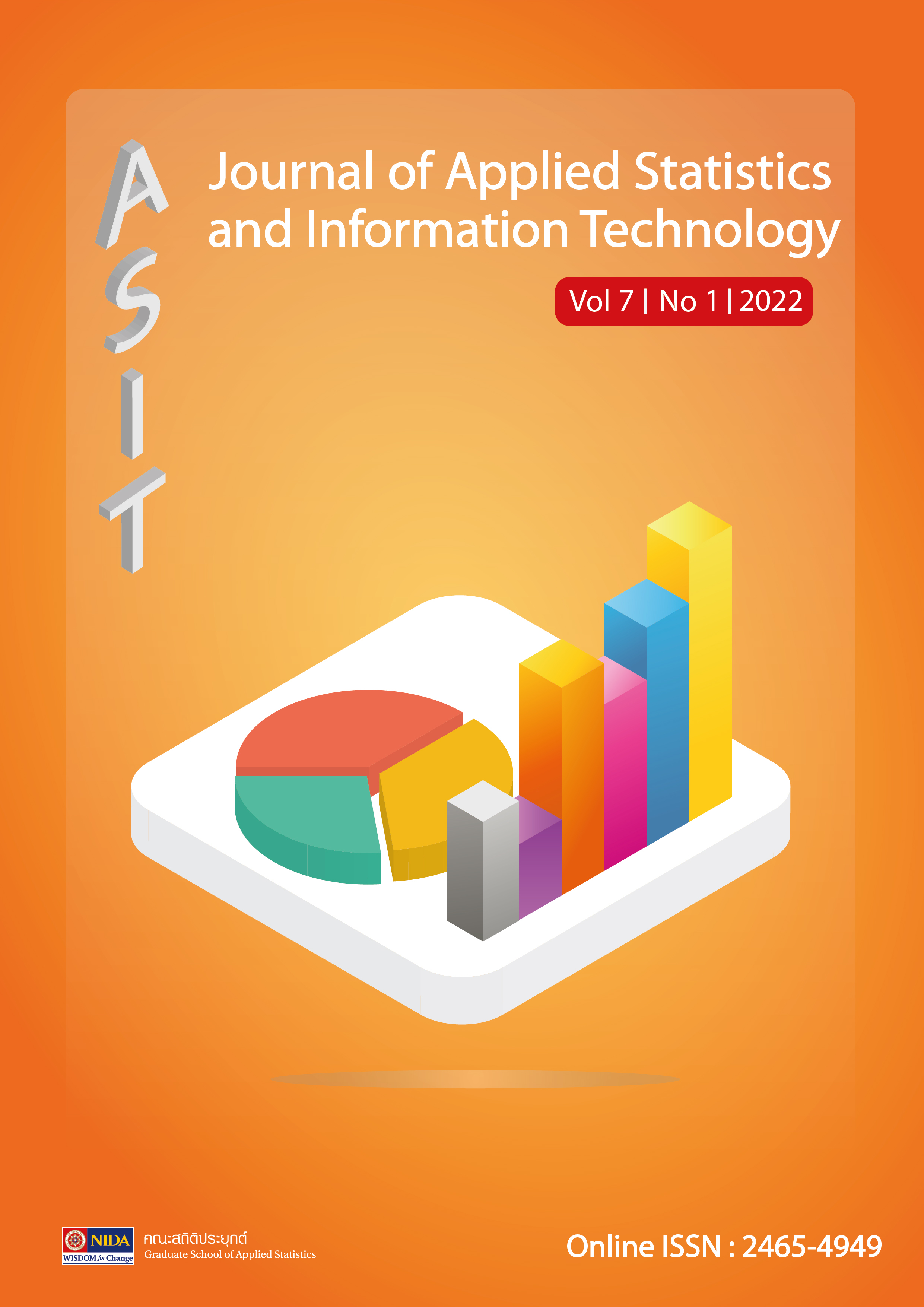การหาตำแหน่งตราสินค้านมโคพาสเจอร์ไรส์จากความเห็นผู้บริโภคบนสื่อสังคมออนไลน์
คำสำคัญ:
เทคนิคการแบ่งสเกลหลายมิติ, การประมวลผลภาษาธรรมชาติ, การวิเคราะห์โครงข่ายเชิงความหมาย, การตรวจหาเครือข่ายชุมชนบทคัดย่อ
ในปัจจุบัน การแข่งขันทางธุรกิจที่เข้มข้น และเทคโนโลยีที่พัฒนาอย่างรวดเร็ว ทำให้ทุกอุตสาหกรรมพิจารณาการสร้างสินค้าใหม่ให้แตกต่างจากคู่แข่ง เพื่อให้สินค้านั้นมีความโดดเด่นกว่าสินค้าอื่นในตลาด และทำให้ผู้บริโภคสามารถจดจำสินค้านั้นได้ เมื่อองค์กรต้องการผลิตและขายสินค้าใหม่ องค์กรมักเริ่มจากการแบ่งกลุ่มตลาด การกำหนดเป้าหมาย และการกำหนดตำแหน่งของตลาด เพื่อให้สินค้านั้นสามารถครองใจผู้บริโภคและอยู่รอดในตลาดได้ การศึกษานี้มีวัตถุประสงค์ในการหาตำแหน่งตราสินค้าของนมโคพร้อมดื่มพาสเจอร์ไรส์ในประเทศไทยจำนวน 7 ตราสินค้าที่วางขายในตลาดด้วยข้อมูลความเห็นผู้บริโภคบนสื่อสังคมออนไลน์ Pantip.com นำความเห็นมาตัดคำ คัดเลือกคำสำคัญ 500 คำ โดยใช้เทคนิคการประมวลผลภาษาธรรมชาติ ก่อนจัดตำแหน่งตราสินค้าโดยใช้เทคนิคการแบ่งสเกลหลายมิติตามมุมมองปัจจัยที่ผู้บริโภคพิจารณาในการบริโภคนมโคพาสเจอร์ไรส์ 8 ด้าน พร้อมเทียบผลกับการรับรู้ตำแหน่งตราสินค้าจากแบบสอบถามที่สร้างขึ้นจากมุมมองปัจจัย 8 ด้านเช่นกัน จากนั้นจึงสร้างกราฟโครงข่ายเชิงความหมายเพื่อพิจารณาความเชื่อมโยงระหว่างคำสำคัญ รวมถึงค้นหาข้อมูลเชิงลึกโดยใช้เทคนิคการตรวจหาเครือข่ายชุมชน พบว่าการจัดตำแหน่งตราสินค้าด้วยการแบ่งสเกลหลายมิติ เมื่อเปรียบเทียบความสัมพันธ์ระหว่างข้อมูลจากแบบสอบถามและข้อมูลจาก Pantip.com มีค่าสหสัมพันธ์ QAP เท่ากับ 0.56 และ pseudo p-value เท่ากับ 0.01 ผลการทดสอบความแข็งแกร่งของสถิติพบว่ามีความแข็งแกร่งในระดับสูง
เอกสารอ้างอิง
ชื่นสุมล บุนนาค, บุษราภรณ์ อารีย์. (2557). การวิเคราะห์ตำแหน่งตราสินค้าของผลิตภัณฑ์กระดาษเช็ดหน้าโดยใช้เทคนิคการแบ่งสเกลแบบหลายมิติ. Journal of Business, Economics and Communications, 9(2), 27-38.
ปิยฉัตร ช่างเหล็ก, ยอดมนี เทพานนท์, ณัฐพล พันธุ์ภักดี. (2561). ปัจจัยที่มีผลกับทัศนคติต่อการซื้อนมพาสเจอไรส์ของผู้บริโภคในเขตกรุงเทพมหานคร. การประชุมวิชาการเสนอผลงานวิจัย ระดับชาติและนานาชาติ, 9(1), 935-946.
รังสรรค์ เลิศในสัตย์. (2549). การตลาดเชิงกลยุทธ์เพื่อความสำเร็จสำหรับผู้บริหาร SME. กรุงเทพฯ: สมาคมส่งเสริมเทคโนโลยี (ไทย-ญี่ปุ่น).
สำนักงานพัฒนาธุรกรรมทางอิเล็กทรอนิกส์. (2563). รายงานผลสำรวจพฤติกรรมผู้ใช้อินเทอร์เน็ตในประเทศไทย ปี 2562. กรุงเทพฯ: ผู้แต่ง.
สุภชาติ ชัยณรงค์สิงห์. (2539). การศึกษาปัจจัยที่ส่งผลการบริโภคนมเปรี้ยวพร้อมดื่ม. วิทยานิพนธ์ปริญญาบริหารธุรกิจมหาบัณฑิต สาขาวิชาบริหารธุรกิจ มหาวิทยาลัยเกษมบัณฑิต.
Aaker, D. A. (1996). Building Strong Brands. Free Press, New York.
Blondel, V., Guillaume, J. L., Lambiotte, R., Lefebvre, E. (2008). Fast Unfolding of Communities in Large Networks. Journal of Statistical Mechanics: Theory and Experiment, 2008(10). doi:10.1088/1742-5468/2008/10/P10008
De Alwis, A., Edirisinghe, J., Athauda, A. (2011). Analysis of Factors Affecting Fresh Milk Consumption among the Mid-Country Consumers. Tropical Agricultural Research and Extension, 12(2), 103-109. doi:10.4038/tare.v12i2.2799
Doerfel, M. (1998). What Constitutes Semantic Network Analysis? A Comparison of Research and Methodologies. Connections, 21(2). 16-26.
Henderson, G. R., Iacobucci, D., Calder, B. J. (1998). Brand diagnostics: Mapping branding effects using consumer associative networks. European Journal of Operational Research, 111(2), 306-327.
Qin, H. (1999). Knowledge Discovery through Co-Word Analysis. Library Trends, 48(1). 133-59.
Howard, L. W. (1998). Validating the Competing Values Model as a Representation of Organization Cultures. The International Journal of Organization Analysis, 6(3), 231-250.
Hsu, J. L., & Lin, Y. T. (2006). Consumption and attribute perception of fluid milk in Taiwan. Nutrition & Food Science, 36(3), 177-182.
Kurajdova, K., Petrovicova, J. T., Kascakova, A. (2015). Factors Influencing Milk Consumption and Purchase Behavior - Evidence from Slovakia, Procedia Economics and Finance, 34, 573-580. doi:10.1016/S2212-5671(15)01670-6
Lee, S. J. (2017). Improving Jaccard Index for Measuring Similarity in Collaborative Filtering. International Conference on Information Science and Applications, 2017, 799-806.
Lee, T., Bradlow, E. (2011). Automated Marketing Research Using Online Customer Reviews. Journal of
Marketing Research, 48(5), 881-894.
Malhotra, N. K. (2019). Marketing research: An applied orientation (7th ed.). New York, NY: Pearson.
Malhotra, P., Bhattacharyya, S. (2019). Online Brand Networks: A New Approach to Brand Positioning. SSRN Electronic Journal, doi:10.2139/ssrn.3484520
Netzer, O., Feldman, R., Goldenberg, J., Fresko, M. (2012). Mine Your Own Business: Market-Structure Surveillance Through Text Mining. Marketing Science, 31(3), 521-543.
Newman, M. E. J. (2004). Fast algorithm for detecting community structure in networks. Physical Review E, 69(6), 066133.
Peter, J. P., Olson, J. C., (2010). Consumer Behavior and Marketing Strategy (9th ed.). McGraw-Hill.
Phatthiyaphaibun, W., Chaovavanich, K., Polpanumas, C., Suriyawongkul, A., Lowphansirikul, L. & Chormai, P. (2016). PyThaiNLP: Thai Natural Language Processing in Python. Zenodo, doi:10.5281/zenodo.3519354
Ringel, D., Skiera, B. (2016). Visualizing Asymmetric Competition among More Than 1,000 Products Using Big Search Data. Marketing Science, 35. doi:10.1287/mksc.2015.0950
Rodgers, J. L. (1991). Matrix and Stimulus Sample Sizes in the Weighted MDS Model: Empirical Metric Recovery Functions. Applied Psychological Measurement, 15(1), 71-77.
Sievert, C., Shirley, K. (2014). LDAvis: A method for visualizing and interpreting topics. Workshop on Interactive Language Learning, Visualization, and Interfaces, 63-70. doi:10.13140/2.1.1394.3043.
Simpson, W. (2001). The Quadratic Assignment Procedure (QAP). North American Stata Users' Group Meetings 2001, 1.2.
Tabassum, S., Pereira S. F. F., Fernandes S., Gama J. (2018). Social network analysis: An overview. Wiley Interdisciplinary Reviews: Data Mining and Knowledge Discovery, 8(5). doi:10.1002/widm.1256.
Van Eck, N. J., Waltman, L. (2006). VOS: a new method for visualizing similarities between objects. Advances in Data Analysis: Proceedings of the 30th Annual Conference of the German Classification Society, 299-306. doi:10.1007/978-3-540-70981-7_34
Van Eck, N. J., Waltman, L. (2010). Software survey: VOSviewer, a computer program for bibliometric mapping. Scientometrics, 84, 523-538. doi:10.1007/s11192-009-0146-3
Vemprala, N., Xiong, R. R., Liu, C. Z., Choo, K. K. R. (2019). Where Does My Product Stand? A Social Network Perspective on Online Product Reviews, The 52nd Hawaii International Conference on System Sciences, 2345-2354.
Waltman, L., Van Eck, N. J., Noyons, E. C. M. (2010). A unified approach to mapping and clustering of bibliometric networks. Journal of Informetrics, 4(4), 629-635.
Yin, S., Chen, M., Chen, Y., Xu, Y., Zou, Z., & Wang, Y. (2016). Consumer trust in organic milk of different brands: the role of Chinese organic label. British Food Journal, 118(7), 1769-1782.
ดาวน์โหลด
เผยแพร่แล้ว
รูปแบบการอ้างอิง
ฉบับ
ประเภทบทความ
สัญญาอนุญาต
ลิขสิทธิ์ (c) 2022 วารสารสถิติประยุกต์และเทคโนโลยีสารสนเทศ

อนุญาตภายใต้เงื่อนไข Creative Commons Attribution-NonCommercial-NoDerivatives 4.0 International License.
เนื้อหาและข้อมูลที่ปรากฏในบทความที่ตีพิมพ์ในวารสารสถิติประยุกต์และเทคโนโลยีสารสนเทศถือเป็นความคิดเห็นส่วนบุคคลของผู้เขียนแต่ละท่าน ความผิดพลาดของข้อความและผลที่อาจเกิดจากนำข้อความเหล่านั้นไปใช้ผู้เขียนบทความจะเป็นผู้รับผิดชอบแต่เพียงผู้เดียว
บทความ ข้อมูล เนื้อหา รูปภาพ ฯลฯ ที่ได้รับการตีพิมพ์ในวารสารถือเป็นลิขสิทธิ์ของวารสาร หากบุคคลหรือหน่วยงานใดต้องการนำทั้งหมดหรือส่วนหนึ่งส่วนใดไปเผยแพร่ต่อหรือเพื่อกระทำการใดๆ จะต้องได้รับอนุญาตเป็นลายลักอักษรณ์จากวารสาร ก่อนเท่านั้น



